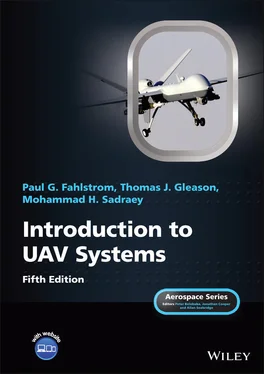After about 10 years of Predator operations, and when some weaknesses were identified, new challenges arose in employing Predator. DOD decided to have a new version of Predator with enhanced performance features and an advanced design. The operation requirements included such performance items as a faster cruising speed and higher flight altitude, and also heavier and more advanced payloads. The conceptual design and the air vehicle configuration were almost kept. The only major configuration change was to have a V‐tail instead of an inverted V‐tail.
The US Air Force first deployed the MQ‐9 Reaper (developed by General Atomics, then called Predator B) to Afghanistan in October 2007 for precision airstrikes and it slowly began replacing the Predator. The General Atomics MQ‐9 Reaper ( Figure 1.5) flew its first operational mission in Iraq in July 2008. In the meantime, the Army began development of a refined derivative, the MQ‐1C Gray Eagle, which began operations in 2012. The US Air Force retired the Predator in 2018, replacing it with the Reaper.

Figure 1.5 General Atomics MQ‐9 Reaper
Left: A British MQ‐9A Reaper operating over Afghanistan in 2009
(Source: Tam McDonald / Wikimedia Commons / OGL v1.0).
Right: CBP’s Reaper
(Source: Gerald L. Nino / Wikimedia Commons / Public Domain)
The first version of Predator (A) had a piston engine, but the upgraded Predator B, or MQ‐9 Reaper, is equipped with a turboprop engine (with a greater power). Predator B is larger, much heavier, with an improved flight performance (e.g., faster cruise speed, longer range, and longer endurance) than the earlier MQ‐1 Predator.
There are two groups of Payloads: (1) surveillance imagery sensors, which include a synthetic aperture radar, electro‐optic video, and forward‐looking infrared (FLIR) cameras, (2) weapon payloads, which include four anti‐armor missiles AGM‐114 Hellfire), two laser‐guided bombs (GBU‐12), and 500 lb joint direct attack munition. Other payload options include a laser designator and rangefinder, electronic support and countermeasures, a moving target indicator (MTI), and an airborne signals intelligence payload.
Reaper UAV has a single turboprop engine on the rear fuselage, a fixed tricycle landing gear, a high aspect ratio wing, with a V‐tail. It has an aileron for roll control and a ruddervator for longitudinal and directional control. The air vehicle is equipped with UHF and VHF radio relay links, a C‐band line‐of‐sight data link, which has a range of 150 nm, and UHF and Ku‐band satellite data links.
The ground control station (GCS) is built into a single 30 ft trailer, containing pilot and payload operator consoles, three data exploitation and mission planning consoles, and two synthetic aperture radar workstations together with satellite and line‐of‐sight ground data terminals. The GCS also includes a data distribution system, which is equipped with a 5.5 m dish antenna or Ku‐band ground data terminal and a 2.4 m dish antenna for data dissemination. The flight can be controlled through line‐of‐site data links or through Ku‐band satellite links to produce a continuous video. Some mass and geometry features as well as flight performance of Reaper are provided in Table 1.2.
Predator and Reaper still have two major weaknesses: (1) the inability to operate in contested airspace with effective enemy air defenses and (2) jamming. These highlight the advances required for future Reaper versions to maintain its operational significance. Jamming can pose a significant threat to the Predator’s data links and GPS navigation.
Table 1.2 Reaper data and performance
| No. |
Parameter |
Value (unit) |
| 1 |
Wingspan |
65 ft 7 in |
| 2 |
Length |
36 ft 1 in |
| 3 |
Maximum takeoff weight |
10,494 lb |
| 4 |
External payload weight |
3,000 lb |
| 5 |
Internal payload weight |
800 lb |
| 6 |
Turboprop engine power |
900 hp |
| 7 |
Maximum speed |
260 knots |
| 8 |
Range |
1,200 mi |
| 9 |
Endurance – fully loaded |
14 hours |
| 10 |
Service ceiling |
50,000 ft |
1.7 Top UAV Manufacturers
The global unmanned aerial vehicle market is witnessing a strong compounded annual growth, even in 2020 where the COVID‐19 emerged as a global pandemic. By January 2019, at least 60 countries were using or developing over 1,300 various UAVs. Top unmanned aerial systems and air vehicles in the market are Northrop Grumman (US), General Atomics (US), AeroVironment (US), Lockheed Martin (US), Elbit Systems (Israel), Israel Aerospace Industries (Israel), BAE Systems (UK), Parrot (France), Microdrones (Germany), SZ DJI Technology (China), Ehang (China), Yuneec International (China), Textron (US), Saab (Sweden), and Raytheon (US). The overall market is expected to reach $21.8 billion by 2027.
A number of European countries (France, Italy, Greece, Spain, Switzerland, and Sweden) are collectively developing the next generation of UCAVs (most notably the nEUROn) and the MALE unmanned aircraft. It is interesting to note that, as of March 2020, DJI accounts for around 70% of the world’s consumer UAV market. The dominant US UAV manufacturers include Boeing, Lockheed Martin, Aurora Flight Sciences, General Atomics, Northrop Grumman, and AeroVironment.
1.8 Ethical Concerns of UAVs
All engineering products share some ethical issues, but the ethical concerns in UAVs are new and not yet regulated. Like other engineering products, there are many ways that UAVs are utilized unlawfully or unethically (e.g., drug trafficking). There are basically two ethical issues in employing UAVs: (1) invasion of privacy and (2) killing innocent individuals (lethal use). For instance, between 2004 to 2010, the US drone program in Pakistan [3] has killed several hundred civilians accidentally.
There are many unanswered questions regarding these two major areas. There are much less ethical concerns regarding mechanical robots than UAVs. When a UAV is flying over houses and is collecting data, this is a case for ethical concern. Due to these concerns, when a user of an UAV does not feel accountability, he/she may trespass the privacy of other citizens and cause loss of life of other individuals.
According to the US government accountability office, there are still four areas of concern for UAVs in using airspace: (1) the inability to recognize and avoid other aircraft, (2) lack of operational standards, (3) vulnerability in command and control of UAV, and (4) lack of Government regulations necessary to safely facilitate the accelerated integration of UAVs into the national airspace system. Moreover, the utilization of unmanned aerial systems for military applications is currently a contested and debated issue.
Having a center in ethics‐informed interdisciplinary research and the integration of ethical literacy throughout the UAV curriculum is a valuable step toward removing ethical concerns. It is promising that AIAA has developed a code of ethics, and recommends all aeronautical engineers to observe these codes in designing and developing air vehicles.
There are concerns about the risks of flying the military UAVs outside war zones. There are reports that US UAVs have repeatedly crashed at civilian airports overseas throughout the world. Among the problems cited in the reports “are pilot error, mechanical failure, software bugs, and poor coordination with civilian air‐traffic controllers. Since an initial report of a crash in January of 2011 at a US base in Djibouti, there have been ‘at least six more Predators and Reapers’ crashes” in the vicinity of civilian airports overseas.
Читать дальше













